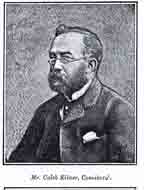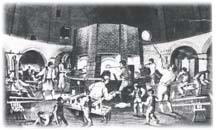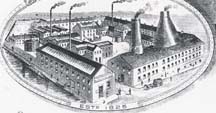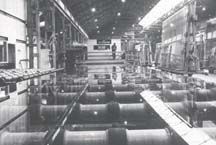|
Introduction
Glass is
produced by melting together silica, usually in the form of sand, and an
alkaline flux such as soda or potash, with the addition of other
ingredients. Glass was known to the ancient Egyptians though the technique
of blowing glass was not introduced until the Roman period. The
construction of glasshouse and furnace altered considerably over the
years. The spectacular English contribution was the lofty brick
glass-cone, which acted as a chimney for the furnace but also housed the
glassmakers, who worked in teams around the furnace in the centre. The
inside the cone, describes the basic glassmaking techniques, and explains
the mysteries of the rich vocabulary that surround this ancient craft.
 Glass
is an artificial, non-crystalline material, categorised as a super-cooled
liquid rather than a solid .As mentioned above the basic ingredient is
silica, usually in the form of a fine sand, to which alkaline fluxes such
as soda or potash are added which bring the melting point down to the
region of 1300 to 1500 degrees C. At this temperature the glass is fluid
like water but before working the temperature is reduced until the glass
has the consistency of honey or treacle .Other ingredients in the
batch, as the mixture of raw materials is called, include lime or lead
oxide, according to the type of glass being made, and a quantity of
cutlet (broken glass), which aids fusion and saves on the costs of
fuel and raw materials. Glass
is an artificial, non-crystalline material, categorised as a super-cooled
liquid rather than a solid .As mentioned above the basic ingredient is
silica, usually in the form of a fine sand, to which alkaline fluxes such
as soda or potash are added which bring the melting point down to the
region of 1300 to 1500 degrees C. At this temperature the glass is fluid
like water but before working the temperature is reduced until the glass
has the consistency of honey or treacle .Other ingredients in the
batch, as the mixture of raw materials is called, include lime or lead
oxide, according to the type of glass being made, and a quantity of
cutlet (broken glass), which aids fusion and saves on the costs of
fuel and raw materials.
 To
colour glass, minute quantities of metallic oxides are added to the batch.
About 50 BC it was discovered that molten glass could be blown into a
bubble on the end of a long hollow metal pipe, and present day. After
completion all glass has to be annealed, a very gradual uniform
cooling process which strengthens the glass by removing the stresses that
have built up during manufacture. It is only after annealing that glass is
ready to be decorated by techniques such as engraving or cutting. A close
natural equivalent to glass is the translucent colourless quartz, rock
crystal. Its qualities have been admired and imitated by glassmakers for
centuries and to- day the word crystal is widely used to describe
the best-quality clear glass. Top To
colour glass, minute quantities of metallic oxides are added to the batch.
About 50 BC it was discovered that molten glass could be blown into a
bubble on the end of a long hollow metal pipe, and present day. After
completion all glass has to be annealed, a very gradual uniform
cooling process which strengthens the glass by removing the stresses that
have built up during manufacture. It is only after annealing that glass is
ready to be decorated by techniques such as engraving or cutting. A close
natural equivalent to glass is the translucent colourless quartz, rock
crystal. Its qualities have been admired and imitated by glassmakers for
centuries and to- day the word crystal is widely used to describe
the best-quality clear glass. Top
EARLY
HISTORY
The Roman
author Pliny, writing in the first century AD, tells a delightful story
about how glass was invented. Some Phoenician sailors camped one night on
a beach, lit a fire and set their cooking pots on blocks of natron (soda),
which was the cargo they were carrying. When they awoke the following
morning they found that the heat of the fire had fused the sand and natron
into glass. But nobody knows for certain how glass originated. The
earliest traces have been found in
Mesopotamia from the period 3000 to 2000 BC and from there the art
probably spread to ancient
Egypt.
Before the discovery that glass could be blown on the end of a long hollow
pipe, various forming techniques were used, such as casting and pressing
into moulds, and carving from solid blocks of glass. About 1500 BC the
Egyptians began using a technique called core moulding to make
small vessels for precious ointments and liquids. A core was made from mud
and straw or clay in the shape of the object required and was attached to
the end of a metal rod. It was then dipped in molten glass and trailed
with different colours or it was coated with powdered glass and fired.
Once the glass had cooled the rod was withdrawn and the core picked out.
This technique continued well after the invention of glassblowing. Under
the Romans glassmaking flourished, spreading from its traditional home in
Egypt
and Syria to new corners of the empire such as Germany, France and even
Britain. Top
 By far the most significant event was the invention of glassblowing, which
is thought to have occurred in Syria about 50 BC. It led not only to a new
style of glass but also to a great increase in production, so that from
being a luxury product glass became for the first time a common everyday
article which it was not to be again until the nineteenth century. Cups,
bowls, bottles, jars, jugs and vases formed the majority of the output.
Roman glass often has a green or brown tint due to impurities in the raw
materials but in the second century AD it was discovered that those could
be neutralised by the addition of a small amount manganese oxide.
By far the most significant event was the invention of glassblowing, which
is thought to have occurred in Syria about 50 BC. It led not only to a new
style of glass but also to a great increase in production, so that from
being a luxury product glass became for the first time a common everyday
article which it was not to be again until the nineteenth century. Cups,
bowls, bottles, jars, jugs and vases formed the majority of the output.
Roman glass often has a green or brown tint due to impurities in the raw
materials but in the second century AD it was discovered that those could
be neutralised by the addition of a small amount manganese oxide.
THE
TWENTIETH CENTURY
In
the twentieth century there have been such spectacular advances in glass
technology that glass is now being used in areas that would have been
inconceivable one hundred years ago. One striking example is
heat-resistant ovenware, which was introduced in 1915 by the Coming Glass
Works in the
USA under the famous brand name Pyrex. The borosilicate
glass from which it is made has good chemical stability and low thermal
expansion and can therefore withstand sudden changes in temperature. In
the late 1950s a new material was developed, known as Glass Ceramics,
which, like borosilicate glass, is extremely resistant to thermal shock.
Its strength comes from the fact that a certain amount of crystallization
is allowed to take place during the cooling of the molten glass, and its
applications include cooker hobs and windows for coal and gas fires.
Perhaps the most important technical breakthrough has been the
introduction by Pilkington Brothers of St Helens in 1959 of the float
glass process for the manufacture of flat glass.
 Before float was invented, most flat glass had to be ground and polished
after annealing to remove distortions on the surface caused by the
manufacturing process. In the float glass process, a continuous ribbon of
molten glass from the furnace floats along the surface of a bath of molten
tin in a carefully controlled atmosphere. This not only produces a
perfectly flat glass because the molten tin is flat, but it makes the
laborious grinding and polishing stage redundant because the glass has
become sufficiently hard by the time it leaves the molten tin for its
surface not to be marked by the rollers on which it is taken up and
conveyed to the annealing chamber. Float glass has revolutionised the flat
glass industry and is now used worldwide under licence from Pilkingtons. Top
Before float was invented, most flat glass had to be ground and polished
after annealing to remove distortions on the surface caused by the
manufacturing process. In the float glass process, a continuous ribbon of
molten glass from the furnace floats along the surface of a bath of molten
tin in a carefully controlled atmosphere. This not only produces a
perfectly flat glass because the molten tin is flat, but it makes the
laborious grinding and polishing stage redundant because the glass has
become sufficiently hard by the time it leaves the molten tin for its
surface not to be marked by the rollers on which it is taken up and
conveyed to the annealing chamber. Float glass has revolutionised the flat
glass industry and is now used worldwide under licence from Pilkingtons. Top |
